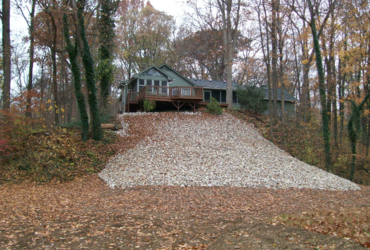How to Control Soil Erosion
Knowing how to control soil erosion can be critical for your property. Soil erosion is not uncommon around a lake, ditch, or hillside and often requires erosion control, or it will get out of control. Erosion can take away from the appearance of your landscape, render areas unusable, and reduce the value of your property.
Central Indiana has experienced a drought this summer, which might lead you to think we’re safe from soil erosion, but that’s not always the case. Remember the dust bowl from the 1930s? Although water is the most common reason for soil erosion, drought can be the cause too. “Climate is also a major driver of erosion. Changes in rainfall and water levels can shift soil, extreme fluctuations in temperature can make topsoil more vulnerable to erosion, and prolonged droughts can prevent plants from growing, leaving soil further exposed.” Natural Resources Defense Council soil erosion 101 causes.
Erosion doesn’t just go away. Uncontained, it will almost always get worse. So, what causes soil erosion, and what can you do about it?
Common Causes of Soil Erosion
- Water: Heavy rainfall, poor drainage systems, and water runoff can all contribute to erosion on residential properties.
- Wind: Strong winds can cause soil to dry out and become loose, leading to erosion.
- Slope: Residential property located on a steep slope means erosion can occur more easily due to gravity.
- Vegetation: Lack of vegetation or improper landscaping can lead to erosion as plants help to hold soil in place.
- Construction: Construction activities such as grading, excavation, and vegetation removal can contribute to erosion on residential properties.
How to Control Soil Erosion
Specific measures need to be taken to control erosion along a lake, ditch, or hillside, including installing specialized fabric and rip rap stone. Here’s a description of the process:
First, a well-defined edge is created at the meeting point of the erosion area and the existing turf on top of the lake, ditch, or hillside. This edge serves as a boundary for erosion control measures.
Next, a geo-textile fabric is carefully applied. This fabric acts as a barrier, preventing the growth of weeds and other vegetation. It helps to maintain the stability of the area and prevents soil erosion.
Following the fabric installation, rip rap stone is strategically placed over the fabric. This serves a dual purpose. It helps to guide the flow of water, ensuring proper drainage. When it rains, the water permeates through the gaps between the rip rap rocks and drains onto the fabric, which directs it to a desired location for effective drainage.
What Is Rip Rap Stone?
Rip rap stone, typically composed of limestone, comes in varying sizes ranging from 6 to 18 inches. Besides reinforcing the fabric and preventing erosion, it also adds aesthetic value to your property, enhancing its appearance.
In summary, erosion control along a lake, ditch, or hillside involves:
- Cutting a defined edge.
- Applying geo-textile fabric as a weed barrier.
- Placing rip rap stone for proper drainage.
This combination of measures not only safeguards against erosion but also enhances the area’s visual appeal.
Another consideration is burying drain tiles or French drains to redirect water away from eroding areas and from your home.
What About Using Vegetation to Stop Soil Erosion?
If the problem isn’t severe, planting vegetation can be a way to control erosion on residential properties. Vegetation helps to stabilize soil and prevent it from being washed away by rain or runoff. The roots of plants hold the soil in place, while the leaves and stems help slow water movement across the soil’s surface. However, this usually only works on low erosion areas, for most soil erosion vegetation alone isn’t enough.
In addition, vegetation can absorb excess water from the soil, reducing the runoff that occurs during heavy rain events. This can help to prevent erosion and protect nearby waterways from sedimentation and pollution.
When selecting plants for erosion control, choosing species well-suited to the local climate and soil conditions is essential. Native plants are often a good choice, as they are adapted to the local environment and can provide additional benefits such as a habitat for wildlife and improved aesthetics.
How Can We Help You?
Berger Hargis has a company philosophy of providing personal excellence for all our services. Our growth and success have been due entirely to our commitment to honest, excellent customer service. The company has been built on the referral business we have received due to this philosophy.
We work with residential customers and businesses in Central Indiana. Contact Us for a free analysis from one of our trained specialists.
About the Author
Randy Clark is a speaker, coach, and author. He publishes a weekly blog at Randy Clark Leadership.com. Randy is passionate about social media, leadership development, and flower gardening. He’s a beer geek, and on weekends he can be found fronting the Rock & Roll band Under the Radar. He’s the proud father of two educators; he has four amazing grandchildren and a wife who dedicates her time to helping others. Randy is the author of the Amazon bestseller The New Manager’s Workbook, a crash course in effective management.
Go Back







